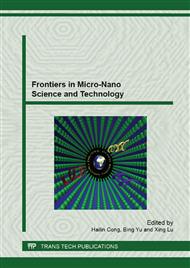[1]
Chou S Y, Krauss P R, Renstrom P J. Imprint of sub-25 nm vias and trenches in polymers[J]. Applied physics letters, 67 (1995) 3114.
DOI: 10.1063/1.114851
Google Scholar
[2]
Austin M, Chou S Y. Fabrication of nanocontacts for molecular devices using nanoimprint lithography[J]. Journal of Vacuum Science & Technology B: Microelectronics and Nanometer Structures, 20(2) (2002) 665-667.
DOI: 10.1116/1.1463068
Google Scholar
[3]
Li N, Wu W, Chou S Y. Sub-20-nm alignment in nanoimprint lithography using Moire fringe[J]. Nano Letters, 6(11) (2006) 2626-2629.
DOI: 10.1021/nl0603395
Google Scholar
[4]
Peng C, Liang X, Chou S Y. A novel method for fabricating sub-16 nm footprint T-gate nanoimprint molds[J]. Nanotechnology, 20(18) (2009) 185302.
DOI: 10.1088/0957-4484/20/18/185302
Google Scholar
[5]
Haisma J, Verheijen M, Van Den Heuvel K, et al. Mold-assisted nanolithography: A process for reliable pattern replication[J]. Journal of Vacuum Science & Technology B: Microelectronics and Nanometer Structures, 14(6) (1996) 4124-4128.
DOI: 10.1116/1.588604
Google Scholar
[6]
Bender M, Plachetka U, Ran J, et al. High resolution lithography with PDMS molds[J]. Journal of Vacuum Science & Technology B: Microelectronics and Nanometer Structures, 6 (2004) 3229-3232.
DOI: 10.1116/1.1824057
Google Scholar
[7]
Plachetka U, Bender M, Fuchs A, et al. Wafer scale patterning by soft UV-nanoimprint lithography[J]. Microelectronic Engineering, 73 (2004) 167-171.
DOI: 10.1016/s0167-9317(04)00093-0
Google Scholar
[8]
Carlberg P, Graczyk M, Sarwe E L, et al. Lift-off process for nanoimprint lithography[J]. Microelectronic engineering, 67 (2003) 203-207.
DOI: 10.1016/s0167-9317(03)00072-8
Google Scholar
[9]
Barbillon G, Hamouda F, Held S, et al. Gold nanoparticles by soft UV nanoimprint lithography coupled to a lift-off process for plasmonic sensing of antibodies[J]. Microelectronic Engineering, 87(5) (2010) 1001-1004.
DOI: 10.1016/j.mee.2009.11.114
Google Scholar
[10]
Hwang S Y, Jung H Y, Jeong J H, et al. Fabrication of nano-sized metal patterns on flexible polyethylene-terephthalate substrate using bi-layer nanoimprint lithography[J]. Thin Solid Films, 517(14) (2009), 4104-4107.
DOI: 10.1016/j.tsf.2009.01.164
Google Scholar
[11]
Park H S, Shin H H, Sung M Y, et al. Novel process to improve defect problems for thermal nanoimprint lithography[J]. Semiconductor Manufacturing, IEEE Transactions on, 20(1) (2007) 13-19.
DOI: 10.1109/tsm.2006.890315
Google Scholar


